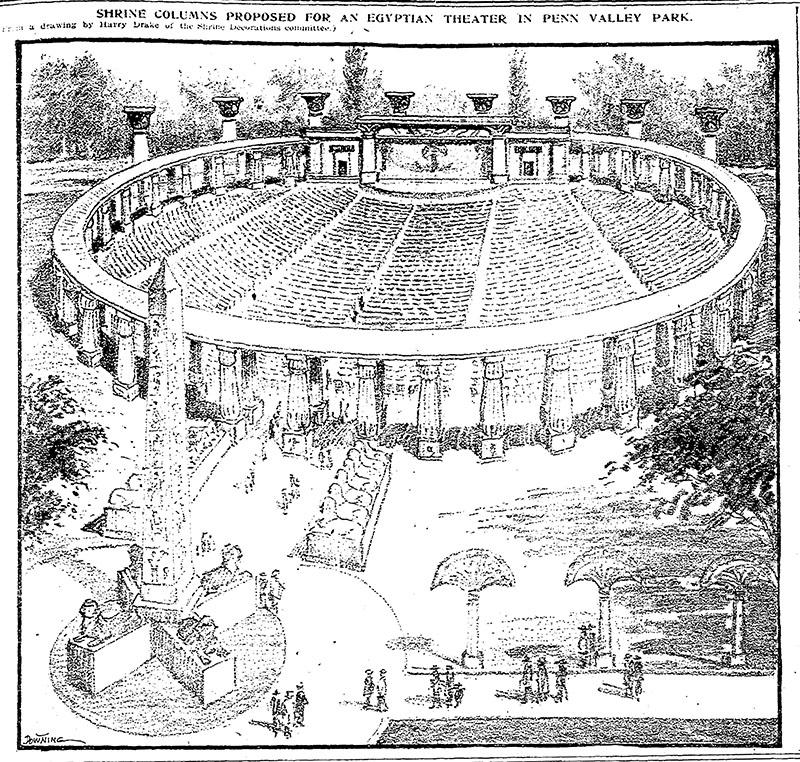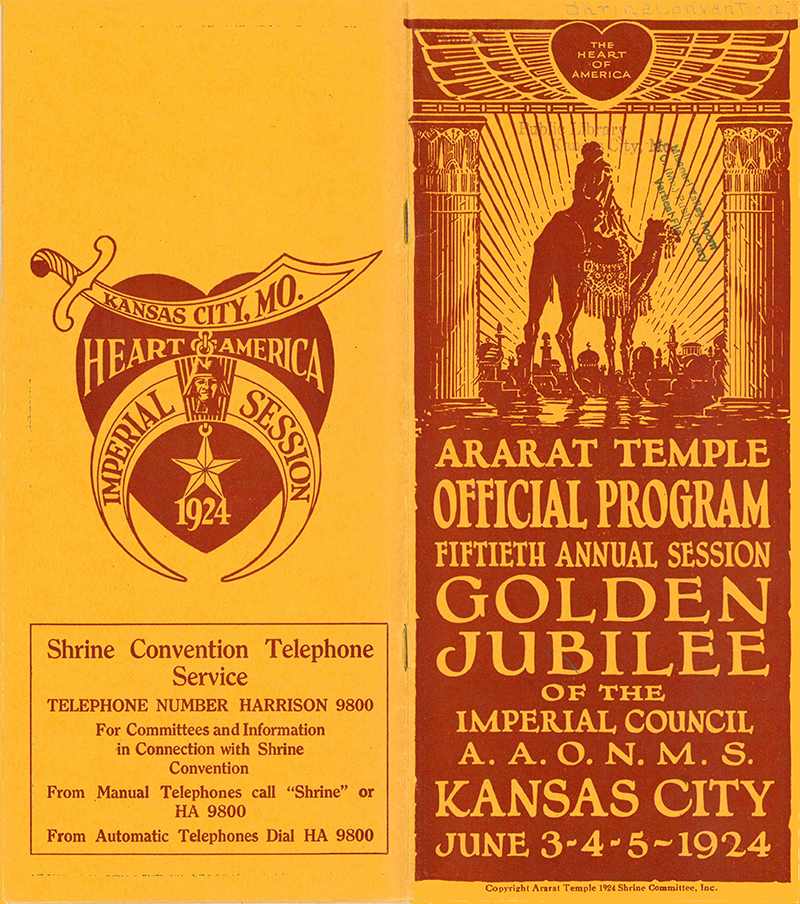Why Were There Egyptian-Style Decorations at Union Station in the 1920s? A KC Q Answered
“What’s your KC Q” is a joint project of the Kansas City Public Library and The Kansas City Star. Readers submit questions, the public votes on which questions to answer, and our team of librarians and reporters dig deep to uncover the answers.
Have a question you want to ask? Submit it now »
By Joanna Marsh, Missouri Valley Special Collections
In this week’s installment of “What’s Your KCQ?” — a series in which we partner with the Kansas City Star to answer reader questions — we dive into a submission from Bill Johnson.
He noticed some Egyptian looking objects in some photographs of Union Station from the 1920s and wondered why they were there.
Shriners parade and ceremonial activities in front of Union Station, 1924, General Photograph Collection (P1), Missouri Valley Special Collections.
The décor in question is from the Shriners convention that took place June 3-5, 1924. The event—the “Golden Jubilee of the Imperial Council A.A.O.N.M.S. Kansas City”—attracted tens of thousands of Shriners from across the country. Locals marveled as downtown was transformed into what the Shriners called “a city of Saracenic Egypt.” Sphinxes, obelisks and painted banners welcomed the gathering fraternity brothers to the Heart of America.
But why Egyptian décor?
The answer lies in the history of the Shriners. Now called Shriners International, the Masonic philanthropic organization has utilized a broad Arabian theme since the 1870s, after founding member William Florence attended a party hosted by an Arabian diplomat. Inspired by the party’s aesthetics, Florence suggested the theme, and fellow founder Walter Fleming christened the new fraternity the Ancient Arabic Order of the Nobles of the Mystic Shrine (A.A.O.N.M.S.) Members donned the signature red fez and, during an early council meeting, it was decided that each new temple be required to choose an ancient Arabic or Egyptian name.
Shriners appeared in Kansas City around 1888, when the Ararat Shrine Temple was granted a charter. By its own account, there is no record as to why the name Ararat was chosen. It is clear, however, that the Kansas City Shriners were proud to host the 1924 event. They used the chosen theme of “ancient and Arabic Egypt” to the fullest. The official program describes the decorations in detail: “(b)lazons of antique Egypt, such as hawk-headed Osiris, and the papyrus scroll fledged with eagles’ wings, and the sphinx, together with the Heart of America Shrine emblem."
The program continues: “Some 100 Egyptian columns have been placed at street intersections, and rows of inscrutable sphinxes line the avenues. The first things the visitors see when coming out of the Union Station are a great obelisk and groups of columns.”Distant view of parade and ceremonial activities in front of Union Station, 1924, General Photograph Collection (P1), Missouri Valley Special Collections.
Called “The Garden of Allah,” the display at Union Station was only the beginning of the revelry.
"Bombs bursting high above Memorial hill announced the arrival of the temples," The Kansas City Times reported. "The Union Station was packed and stretching across the plaza and up the great terraces of Memorial hill was a throng of many thousands there to greet the visitors…"
The Kansas Citian reported 45,000 registrants and an estimated 80,000 visitors in all over the course of the convention, making it the largest event in the city’s history at the time.
Street decorations in front of Sheidley Building, 901 Main, 1924, General Photograph Collection (P1), Missouri Valley Special Collections.
The Golden Jubilee program describes additional décor along Petticoat Lane—renamed “Paradise Alley”—including an obelisk at Main Street and a large sphinx at Grand Avenue. Painted columns lined the downtown streets, and banners were hung along the parade route from Ninth Street to Pershing Road. The convention featured three parades, the first predicted to last four hours. Over 10,000 marchers and 58 bands passed by 50,000 grandstand seats specifically constructed for the occasion.
Distant view of parade heading north on Main near 10th Street, 1924, General Photograph Collection (P1), Missouri Valley Special Collections.
Other events included a civic pageant organized by the Priests of Pallas, a fireworks display, concerts, sporting events, and activities at Electric, Fairmount, and Fairyland parks. After three days of nonstop activities, the Golden Jubilee finally came to an end and local Shriners turned their attention to the next item on the agenda—what to do with the decorations.
Decorations at the corner of 11th and Main, in front of John Taylor Dry Goods Company building, 1924, General Photograph Collection (P1), Missouri Valley Special Collections.
Eager to preserve the artwork, the Shrine decorations committee suggested repurposing the columns and sculptures for an Egyptian-style theater in Penn Valley Park. Committee member Harry Drake drew up a plan for the parks board that was published in The Kansas City Star. The Shriners argued that the open-air theater could be created at little expense to the city and would provide a beautiful venue for summer concerts.

Drawing of proposed plan for Egyptian theater, The Kansas City Star, June 4, 1924.
But the parks board rejected the plan due to the ephemeral nature of the decorations. City art commission members found the painted columns “too fanciful” and impermanent, requiring more maintenance than they were worth.
After hearing these objections, architect Ernest O. Brostrom wrote a letter to The Star urging the board to accept the Shriners’ offer. He argued that the Egyptian-style objects would attract visitors and be a vast improvement to the overgrown land southwest of Liberty Memorial. Addressing the issue of impermanence, he wrote, "Is it not the ruinous conditions of some of the ancient monuments that make their charm and add to their mystic interest?"
Despite enthusiastic appeals from Brostrom and many citizens, the Penn Valley Park plan didn’t pan out. The Shriners hired a transfer company to haul the decorations away, and it proceeded to dump them into the Missouri River until local government intervened. By June 10, what remained of the once-glorious décor was finally discarded at a dump near 15th Street and Winchester Avenue.
To learn more about the Shriners’ Golden Jubilee, readers can access the resources used for this article in the Library’s Missouri Valley Room. They include the P1 General Photograph Collection, the Shriners vertical file and the Ararat Temple Official Program



